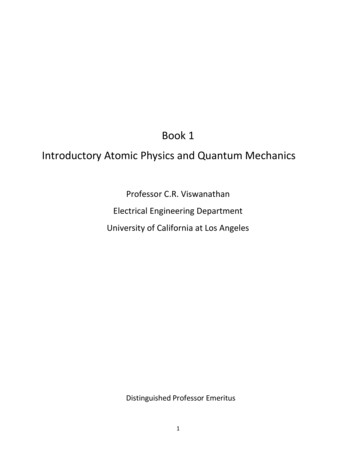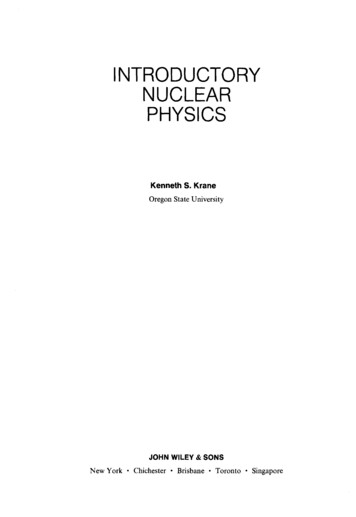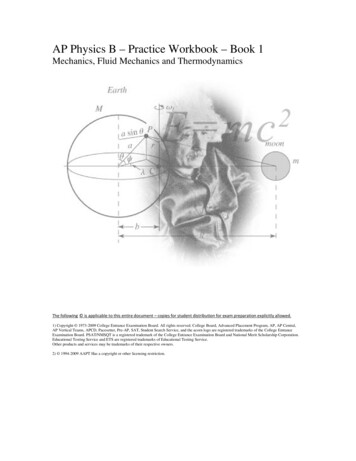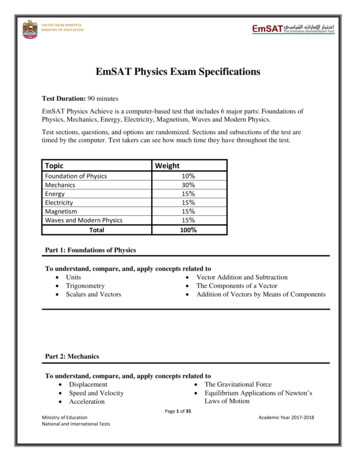
Transcription
Book 1Introductory Atomic Physics and Quantum MechanicsProfessor C.R. ViswanathanElectrical Engineering DepartmentUniversity of California at Los AngelesDistinguished Professor Emeritus1
Chapter 1Introductory Atomic PhysicsI.1.1 IntroductionAn understanding of modern solid state theory is possible only after thefundamentals of quantum mechanical principles and the application of theseprinciples to atomic systems are clearly understood. With this in mind, we willproceed to develop the concepts of quantum mechanics and their application tophysical systems in Part I of the book. In Chapter I, we will trace the inability ofconcepts of classical physics to explain some of the experimental observedphenomena, In particular, classical physics proved to be unsuccessful in thefollowing areas:(1) Inability to provide a satisfactory theory of the atom(2) Inability to explain the characteristic spectral lines of the variouselements(3) Failure to provide a theory for the observe characteristics of thermalradiation(4) inadequacy to explain the photoelectric phenomenonPlanck (thermal radiation), Einstein (Photoelectric effect) and Bohr (atomicmodel) made some bold assumptions to remove the failures of classical physics.Each made hypothetical assumptions to suit his particular model. There was nojustification for these assumptions other than the fact that the model explainedthe experimental results.In the following paragraphs we will discuss the above failures of classicalphysics and the models of Planck, Einstein and Bohr.I.1.2 Early Atomic TheoriesAs in other fields, the early Greeks contributed to the modern atomictheory. Democritus (460-370 BC) postulated that “the universe consists of emptyspace and an almost infinite number of indivisible and invisible particles” whichdiffer in form, position and arrangement. These elementary particles were calledatoms. The developments in the field of chemistry in the 19th century led to the2
distinction between atoms and molecules. A collection of atoms of one typewhich cannot be decomposed into simpler units by any chemical transformationis called an element. The elements can be combined in many ways to formcompounds. The smallest particle preserving the characteristics of the compoundis called the molecule and the smallest particle similarly preserving thecharacteristics of the element is called the atom. The size of the atom or themolecule is so small that only indirect evidence for their existence can obtained.The interest in atomic structure was renewed with the discovery ofelectrons in low pressure gas discharge experiments towards the end of the 19thcentury. Since electrons came from atoms it was surmised that any model for thestructure of atoms should have electrons in it. Since electrons are negative incharge and atoms are neutral, it was concluded that the atoms also continuedpositive charge to neutral, it was concluded that the atoms also containedpositive charge to neutralize the electronic charge. Then two questions arose-howmany electrons are there in an atom, and how are these electrons and positivecharges arranged within an atom? Rutherford, based on his alpha-particleexperiment, proposed a new model for an atom in which he said that the positivecharge and most of the atomic mass are concentrated in a very small centralregion which came to be called later, the nucleus, about which the electrons aregrouped in some sort of configuration, Rutherford’s model suffered from manydisadvantages because it did not say anything about the location or movement ofthe electrons or the nucleus. It gave no explanation on how these electrons couldremain in equilibrium about the nucleus. If, as in planetary motion, electronswere assumed to be moving in an orbit, then classical theory would lead to loss ofenergy through radiation which would cause the electron to spiral towards thenucleus and finally fall into the nucleus. Another defect of the Rutherford modelwas that it did not explain the observed spectroscopic effect.I.1.3 Early SpectroscopyIn 1666 Isaac Newton discovered that white light could be split up intocomponent colors by means of a prism. By the beginning of the 19th century,wave theory of light was generally accepted. According to this theory, light is awave phenomenon and the colors of light are due to waves of different3
wavelengths or frequencies. When light given off by an ionized vapor of anelement was examined with a prism or a grating which had better resolution thana prism, the spectrum that was obtained consisted not of just a continuousspectrum, but a series of lines in the spectrum. Such spectra were different fromelement to element but it was always the same for a particular element. In 1885,Balmer discovered that the wavelength of the nine then known lines in thespectrum of hydrogen can be expressed very closely by the formula𝜆 𝑏𝑛2𝑛2 4where 𝑛 integer greater than 2(I.1.1)If 𝜆, the wavelength is expressed in Angstrom units (10 10 𝑚𝑚𝑚𝑚𝑚), then 𝑏 turnedout to be 3645.6. 𝑛 is a variable integer which takes on successive integral valuesgreater than 2; namely, 3,4,5, etc. In announcing this discovery Balmer raised thequestion as to whether or not his formula might be a special case of a moregeneral formula applicable to other series of lines in other elements. Rydbergcarried experimental work further and found that a universal formula for linewavelengths of all spectra exists in the form1𝜆 1𝜆1 𝑅𝑛2(I.1.2)where 𝜆1 is equal to the short wavelength limit of the series and 𝑛 is an integerwith a particular lower limit for each series. 𝑅 is equal to a universal constantcalled the Rydberg constant and is numerically equal to 1.0974 10 7 𝑚 1 .With such obvious order in the spectral of hydrogen and other elements itappeared that any model of atomic structure should be capable of explaining thespectral series and give quantitative agreement to the wavelengths of theobserved spectral series. But, as pointed out earlier, Rutherford’s model could notexplain the spectral series that was observe by Balmer or Rydberg. It was not untilBohr used some bold assumptions in proposing a new atom model that thespectral series was explained.I.1.4 Thermal RadiationWhen a body is heated it emits energy in the form of radiation and thequantity and quality of the radiation depends on the temperature of the body.4
When an incandescent lamp filament is heated the amount of energy radiated bythe filament in unit time increases rapidly with increase in the temperature of thefilament. The spectral characteristic of the emitted energy also changes as thetemperature increases. It is also known that when thermal or light energy falls ona body, the body absorbs some of the energy and scatters the rest of the energy.At thermal equilibrium the amount of energy emitted by a body is the same asthe amount of energy absorbed by the body. An ideal black surface is defined asthat one which has the property that it absorbs completely all the radiation that isincident on that surface, none of the radiation being reflected. Since in thermalequilibrium the amount of energy emitted is the same as the amount of energyabsorbed, black surface is also an ideal radiator. 𝛼 , the absorption coefficient, isequal to 1 𝑟 where 𝑟 is the reflection coefficient.It was shown by Hertz that visible and electromagnetic radiation were thesame phenomena. The electromagnetic spectrum starts from a very lowfrequency radio wave through ultrahigh frequency radio wave. If the frequency israised still farther we go to heat waves after which comes the visible spectrumand then the 𝑥-rays. The visible spectrum which is sandwiched between theinfrared heat waves and the ultraviolet waves is just a small part of the entirespectrum. Therefore, thermal radiation, radio waves, light waves, are all one andthe same. The energy that is emitted by a black body at a particular temperatureis not uniformly distributed over the entire spectrum. There is a particularwavelength for a given temperature at which maximum radiation of energy takesplace. This was stated as a law by Wien and Wien’s displacement law states thatas the temperature of a black body is raised, the wavelength at which maximumemission occurs, move in the direction of shorter wavelength such that theproduct 𝜆𝑚𝑚𝑚 𝑇 is a constant. It was found experimentally by Lummer andPringsheim that 𝜆𝑚𝑚𝑚 𝑇 0.2896 𝑐𝑐 degrees.The total radiation of energy (irrespective of the spectral distribution) wasfound to be varying as the fourth power of the absolute temperature. This iscalled Stefan’s Law which was empirically derived according to which𝐼𝑇 𝜎𝑇 4(I.1.3)Where 𝐼𝑇 total energy emitted (over the entire wavelength spectrum) per unittime by unit area of a black body at temperature 𝑇. 𝜎 is called Stefan’s constant5
and is equal to 5.67 Joules/ 𝑚𝑚𝑚𝑚𝑚 2 𝑑𝑑𝑑𝑑𝑑𝑑 4 𝑠𝑠𝑠. If the body was not an idealblack body but was characterized by an emissive power 𝜖 1, 𝑡ℎ𝑒𝑒 𝐼𝑇 was givenby𝐼𝑇 𝜖𝜖𝑇 4(I.1.4)Two notable theories were advanced to explain the spectral variation ofthermal radiation by a hot body. The first is called Wien’s Displacement Law andthe second is called Rayleigh-Jean Theory. Either of the two theories was notsatisfactory in that, the first one did not give the functional form of thedependence of spectral distribution on 𝜆𝜆 and the latter theory agreed withexperimental results only a long wavelengths, i.e., much longer than 𝜆𝑚𝑚𝑚 .The spectral distribution of energy radiated by a black body was correctlydetermined by Planck. He assumed the existence of one dimensional harmonicoscillators which interacted with the radiation field. He hypothesize that(i)(ii)(iii)Each oscillator absorbs energy from the radiation field continuouslyaccording to the laws of electrodynamics.An oscillator can radiate energy only when its total energy is an exactintegral multiple of a certain unit of energy for that oscillator. Whenit radiates it radiates all of its energy.The probability of non-emission to emission of energy is proportionalto the intensity of the radiation that excites the oscillator.Planck assumed that the oscillator would radiate energy when its energy is equalto 𝑛ℎ𝜐where 𝜐 frequency of the oscillator𝑛 Integerℎ a constant called Planck’s constantIn other words, Planck quantize the energy of the oscillator to be an integralmultiple of a unit of energy equal to ℎ𝜐. Using these hypotheses, he arrived at thefollowing expression for the actual energy distribution:𝐼 (𝜆, 𝑇)𝑑𝑑 2𝜋𝑐 2 ℎ𝑐ℎ𝜆5 𝑒 𝜆𝜆𝜆 1 6𝑑𝑑(I.1.5)
The numerical value of Planck’s constant ℎ is equal to 6.62562 10 34 𝐽𝐽𝐽𝐽𝐽 𝑠𝑠𝑠.where 𝐼(𝜆, 𝑇)𝑑𝑑 is the energy radiated by the unit area of the black body in unittime at temperature T, between wavelengths 𝝀 and 𝝀 d𝝀.I.1.5 Einstein’s Photoelectric EquationPlanck’s hypothesis quantized only the energy of the oscillator and not theenergy of the electromagnetic field.It was Einstein who proposed that the radiation field itself should bequantized and he put forward the famous photoelectric equation to explain theobserved facts of photoelectric phenomenon. The experimental verification ofEinstein’s photoelectric equation put Planck’s quantum hypothesis on a soundbasis.The photoelectric effect was first discovered by Hertz on 1887. Hisapparatus is shown in Figure I.1.1. A polished metal electrode called the cathodeand perforated metal plate called the anode are contained in an evacuated glasschamber. When a positive potential is applied to the anode with respect to thecathode and ultraviolet light falls on the cathode, electrons are emitted by thecathode and collected by the anode and a current flows through the ammeter inthe external circuit. This phenomenon is called the photoelectric phenomenon.7
Referring to the apparatus shown in Figure (I.1.1) if the voltage on theanode is reduced to zero and then made negative, some of the photoelectronswill be repelled. At some value of negative voltage, 𝑉0 , even the most energeticelectron will be repelled and this value of voltage, 𝑉0 , is known as the cut-offvoltage. A plot of the photoelectric current 𝐼 versus the anode voltage 𝑉,obtained typically in an experiment for various values of incident intensity ofmonochromatic beam of light is shown in Figure (I.1.2).The maximum energy of the electron ejected from the cathode is equal to 𝑉0 where 𝑉0 is the cut-off voltage. As we increase the intensity of light fallingon the cathode (measured in joules per second). We will expect classically theadded energy to increase the kinetic energy of the emitted electrons andtherefore the cut-off voltage 𝑉0 should vary with the intensity of light, a higherintensity giving rise to a more negative cut-off voltage. But experiment does notagree with this prediction, as shown in Figure (I.1.2), where the cut-off voltageremains a constant independent of the intensity.8
On the other hand, if the frequency of the incident monochromatic beamof light is varied keeping the intensity constant, the experimental i-v curves shownin Figure (I.1.3) are obtained. These curves show that the cut-off voltage varieswith the frequency of the incident light, higher frequency corresponding to amore negative cut-off voltage. This showed that the maximum energy of theejected electrons increased with the frequency of the incident light beam. Thisresult could not be explained classically.Einstein gave a successful explanation of the photoelectric phenomenon byproposing that the radiation field itself be quantized. According to Einstein’sphotoelectric theory, energy is discrete and not indefinitely divisible. The smallestunit of energy which can be absorbed or emitted in a single process is called aquantum. A quantum of radiation energy (electromagnetic waves) is called aphoton. The energy 𝐸 of a photon is proportional to the frequency 𝜐, of theelectromagnetic wave and the constant of proportionality is Planck’s constant ℎ.i.e., 𝐸 ℎ 𝜐The light falling on the metal can act only as photons of energy hitting thesurface of the metal. If a photon is absorbed, it means that some electron has9
increased its energy by an amount equal to the photon energy. Normally theelectrons are bound to the surface of the metal by a potential barrier called thesurface barrier, i.e., it takes a certain amount of energy to pull an electron outfrom the metallic surface. The electrons have some energy inside the metal butthis is not sufficient for them to overcome the surface barrier. The energy of theelectrons inside the metal follows some distribution law. The difference betweenthe height of the surface barrier and the energy of the most energetic electrons,called the work function of the metallic surface, (Figure I.1.4) represents theminimum amount that the electrons should increase their energy by, so that atleast some electrons will be freed from the metallic surface. The electrons leavingthe metallic surface have some initial velocity and a negative voltage on theanode tends to repel theses ejected electrons. At any given negative voltage – 𝑉,on the anode with respect to the cathode, only those electrons whose initialvelocity 𝑣 satisfies the relation12𝑚 𝑣2 𝑒 𝑉where 𝑒 electronic charge𝑚 mass of the electronwill be able to reach the anode. At the cut-off voltage 𝑉0 , even the mostenergetic electrons are just turned away from reaching the anode. This meansthat the energy of the photon is just equal to the sum of the work function , andthe energy barrier 𝑒𝑉0 due to the retarding voltage on the anode, i.e.,orℎ 𝜐 𝑒𝑉0𝑉0 ℎ𝜐𝑒 𝑒(I.1.7)This equation is known as Einstein’s photoelectric equation. This predicts a linearrelationship between the cut-off voltage and the frequency of theelectromagnetic radiation, and is experimentally verified as shown by the straightline graph in Figure (I.1.5). Thus Einstein’s photoelectric equation confirmedPlanck’s quantum hypothesis. However, the most striking confirmation was givenby Bohr in his model of the hydrogen atom.10
11
I.1.6 Bohr AtomRutherford’s nuclear model of the atom could not satisfy the stabilitycriterion based on classical theory of electromagnetism. The electrostaticattractive force between the nucleus and the electron can be balanced by thecentrifugal force if the electron is assumed to be rotating around the nucleus. Onthe other hand, an accelerating electron has to radiate energy according toclassical theory and, therefore, would eventually collapse on the nucleus. Thisapparent conflict was resolved in 1913 by Niels Bohr who gave a successful modelof the hydrogen atom Bohr postulated that:(1) The hydrogen atom consists of heavy nucleus with a positive charge andan electron (negative charge) moving in a circular orbit as in a planetarymotion, under the action of the electrostatic attraction between thenucleus and the electron.(2) Instead of moving in any circular orbit with a radius anywhere from 0 toinfinity, it is possible for the electron to move only in orbits for whichthe angular momentum is an integral multiple ofℎ2𝜋, where ℎ is Planck’sconstant.(3) An electron moving in an allowed orbit of energy though under constantacceleration, does not radiate energy and therefore has constantenergy.(4) If an electron, initially in an orbit of energy 𝐸𝑖 , jumps to an orbit ofenergy 𝐸𝑓 (𝐸𝑖 𝐸𝑓 ), electromagnetic radiation is emitted with afrequency υ𝐸𝑖 𝐸𝑓𝜐 ℎThese postulates laid down by Bohr, combine classical and non-classicalphysics. The first postulate accepts the idea of a nucleus and an electronremaining in equilibrium according to the laws of classical electrostatics andclassical mechanics. The second postulate quantizes the orbital angularmomentum, and, therefore, the energy. Bohr’s quantization of the orbital angularmomentum is a particular case of a more general quantization rule laid downlater by Sommerfeld according to which the phase integral of any variable over acomplete cycle of its motion must be equal to an integral number of ℎ:12
𝑝𝑖 𝑑𝑞𝑖 𝑛𝑖 ℎIn this formula, 𝑝𝑖 is the generalized momentum conjugate to begeneralized coordinate 𝑞𝑖 and means an integral over a complete cycle of itsmotion. Thus if 𝑞𝑖 is an angle, 𝑝𝑖 is the corresponding angular momentum. If 𝑞𝑖 isthe position coordinate then 𝑝𝑖 is the component of the linear momentumcorresponding to 𝑞𝑖 .The third postulate again violates classical physics according to whichaccelerated electrons should radiate energy. The fourth postulates is calledEinstein’s frequency condition.We can now proceed to determine the energy states of the hydrogen atom.Consider the heavy nucleus of charge 𝑒 to be fixed in space and the elctron (ofcharge – 𝑒) which is very light in comparison to the heavy nucleus, to be rotatingin a circular orbit around the nucleus, as shown in (Figure I.1.6)The electrostatic attractive force between the nucleus and the electron is given byCoulomb’s law to be:𝑒2𝐹 4 𝜋 𝜖0 𝑟 2where 𝜖0 permittivity of free space.The centrifugal force balances the electrostatic attractive force and therefore:13
𝑚𝑣 2𝑟where 𝑚 mass of the electron 𝑍𝑒 214𝜋𝜖0 𝑟 2(I.1.8)𝑣 velocity of the electron in its orbit𝑟 radius of the orbitAccording to Bohr’s second postulate, the angular momentum is quantized, i.e.,𝑚𝑣𝑟 𝑛From Equation (I.1.8), we have𝑚𝑣 2 ℎ2𝜋 𝑛ℏ𝑒24 𝜋 𝜖0 𝑟 2(I.1.9)(I.1.10)Squaring (I.1.9) and substituting (I.1.10) we havei.e.,𝑒2𝑚 𝑟 2 𝑛 2 ℏ24 𝜋 𝜖0 𝑟𝑟 4 𝜋 𝜖0 𝑛2 ℎ2𝑚 𝑒2(I.1.11)We will now calculate the total energy of the hydrogen atom with an electron inone of the allowed orbits. The potential energy is defined to be zero when theelectron is at infinite distance from the nucleus. Then the potential energy 𝑉, at adistance 𝑟 is obtained by integrating the work done in bringing the elctron frominfinity to 𝑟:𝑟𝑒2 𝑒2𝑉 𝑑𝑑 24 𝜋 𝜖0 𝑟 4 𝜋 𝜖0 𝑟1The kinetic energy, T, is equal to 𝑚𝑣 2 and from (I.1.10) is equal to2111𝑒222𝑇 𝑚𝑣 𝑚𝑣 222 4 𝜋 𝜖0 𝑟The total energy 𝐸 is equal to14
𝐸 𝑇 𝑉 1𝑒22 4 𝜋 𝜖0 𝑟(I.1.12)Substituting for r from (I.1.11) in (I.1.2) we have𝐸 𝑚 𝑒 432 𝜋2𝜖02 ℏ21𝑛2(I.1.13)We see that the energy depends upon the integral number ‘𝑛’ which was used toquantize the orbital angular momentum. Since there is a negative sign before theexpression for energy in (I.1.13), the energy increases with increasing values of 𝑛.The lowest energy occurs when n is a minimum, i.e., 𝑛 1 (𝑛 0 is notpermissible since this will correspond to a radius equal to zero). Therefore, thesmallest of these orbits corresponding to 𝑛 1 is the one that the electron willoccupy when the atom is in the “ground” state or when the atom is unexcited.The energy of each orbit as evaluated from Equation (I.1.13) is shown inFigure I.1.7. Hereafter, we will refer to the quantitation number n as quantumnumber. We will next set up the expression for the frequency of theelectromagnetic radiation emitted when an electron jumps from an orbit ofhigher energy to one of lower energy. Let the electron be initially in an orbitcharacterized by the quantum number 𝑛𝑖 and energy 𝐸𝑖 and let it jump to another15
orbit with quantum number 𝑛𝑓 and energy 𝐸𝑓 . Then the frequency ofelectdomagnetic radiation according to Einstein’s frequency condition is𝐸𝑖 𝐸𝑓 1𝑚 𝑒411υ ℎℎ32 𝜋 2 𝜖0 2 ℏ2 𝑛𝑖2 𝑛𝑓2𝑚 𝑒411 8 𝜖0 2 ℎ3 𝑛𝑓2 𝑛𝑖2In terms of the wave number 𝑣̅ , this becomes𝑣̅ 8 𝜖0 2 ℎ311𝑓𝑚 𝑒48 𝜖0 2 ℎ31 𝑛 2 𝑛 2 𝑓1𝑣̅ 𝑅 2 2 𝑛𝑛Where𝑅 𝑚 𝑒4𝑖𝑖(I.1.15A)(I.1.15A)called the Ryberg constantThe quantitative predictions of Bohr’s theory ae contained in Equations(I.1.11), (I.1.13), (I.1.14) and (I.1.15). Normally the hydrogen atom is in the loweststate or ground state (𝑛 1). It receives energy either from collisions as inelectric discharge or by absorption of electromagnetic radiation of suitablefrequency and gets excited, i.e., it jumps to higher energy state (𝑛 1). Since allphysical systems are stable only in their lowest energy state, the atom will emitthe excess energy and return to the ground state. The frequency of the emittedphoton will be governed by Equation (I.1.14).Earlier we had said that any satisfactory model of the atom should explainthe spectroscopic series of lines obtained experimentally. Now, we see thatEquation (I.1.15B) is in such a form that Balmer’s empirical formula can beobtained by putting 𝑛𝑓 2.For,16
𝜆 1 𝑣̅ 111𝑅 2 2 𝑛𝑓 𝑛𝑖41𝑛𝑖2 2𝑅𝑛 4𝑖 𝑏11 1𝑅 2 4 𝑛𝑖𝑛𝑖2𝑛𝑖2 4where 𝑏 4𝑅It can be also be verified that Rydberg’s universal formula can be derived. Otherseries of lines in the spectrum of hydrogen corresponding to other final states,i.e., other values of 𝑛𝑓 were later found. The Laman series which is in theultraviolet region corresponds to 𝑛𝑓 1 as shown in Figure I.1.8. Paschen serieswhich lies in the infrared region ends up in the terminal state 𝑛𝑓 3 and similarlyBrackett series lying in the far infrared region corresponds to 𝑛𝑓 4. The Bohrtheory thus gave an expression not only explaining the various spectral series butalso quantitatively predicting the value for the coefficient R (Rydberg’s constant)which was previously obtained experimentally.It must be pointed out that the formula developed fort the hydrogen atomcan also be applied with suitable but minor modifications to any atom or ionhaving one electron circling around the nucleus. For example, an ion with anuclear charge 𝑍𝑍 and an electron circling around it would have the additionalfactor 𝑍 2 in the expression for its energy.Or𝐸𝑛 𝒁𝟐 𝑅 𝑐 ℎ𝒏𝟐11𝑣̅ 𝑍 2 𝑅 2 2 𝑛𝑓 𝑛𝑖In the case of singly ionized helium whose atomic number 𝑍 2, we will have11𝑣̅ 4 𝑅 2 2 𝑛𝑓 𝑛𝑖From refinements were added to Bohr’s theory when the effect of the finitemass of the nucleus and therefore the motion of nucleus (in Bohr’s model, thenucleus was assumed fixed) were taken into account. Again, as instrumentbecame more precise; it was found that there were more spectroscopic lines than17
what a single quantum number 𝑛 could account for. Bohr’s circular orbit modelwas extended to include elliptical orbits using an additional quantum number 𝑘.Thje energy or the orbit was still determine only by the first quantum number 𝑛.The quantum number 𝑘 specifies the angular momentum to be 𝑘 ℏ (instead of 𝑛ℏ𝑘in Bohr’s model). The ratio also determines the ratio of the minor to major axis𝑛of the ellipse. 𝑘 can take integral values 1 to n.In spite of all these refinements and modifications, Bohr theory was notable to explain the spectra of complex elements. Bohr’s theory was fairlysuccessful in explaining the spectra of hydrogenic ions and atoms, i.e., atoms witha single planetary electron around a central charge. But it failed to explain thespectra of even simple elements like helium. Bohr theory had a logicalinconsistency as explained earlier, in that it combined the concepts of orbitsderived on the basis of classical mechanics with non-classical concepts ofquantum transitions. It was necessary to have a new point of view and this wasprovided by quantum mechanics.18
I.1.7 Digression on Units of EnergyIn addition to using Joule as a unit of energy it is sometimes more practicalto use other units of energy. One electron-volt is a widely used unit of energy inelectronics and is equal to the energy of an electron which has been acceleratedthrough a potential of q volt. The kinetic energy acquired by an electron fallingthrough a potential of 𝑉 volt is equal of 𝑒𝑒 joules where 𝑒 1.602 10 19coulombs. Therefore, 1 electron-volt 1.602 10 19 joules.The energy 𝐸 of a photon of electromagnetic radiation is given by 𝐸 ℎ𝑣where 𝑣 frequency of the electromagnetic radiation. The frequency ofalternately the wave number can therefore be used as a measure of energy. Wavenumbers are usually expressed in units of reciprocal centimeter𝑣̅ 1 𝜐𝑐where c is the velocity of light in cm/secondSince ℎ 6.62 10 34 Joules secAnd 𝑐 3 1010where 𝜆𝑣𝑣𝑣 is in cm𝜆𝑣𝑣𝑣𝑐𝑐𝐸 ℎ 𝑐 𝑣̅𝑠𝑠𝑠One 𝑐𝑐 1 1.9858 10 23 Joules 1.2395 10 4 eVConversion from one unit to another is given in Table 1.19
Table 1Conversion Factors of Energy UnitsunitJouleJoule1Electron-VolteV𝑐𝑐 1Electron-Volt(eV)1.602 10 196.2 10185.03 10221.2395 10 4111.9858 10 2320𝑐𝑐 18.067.5
Problem: Chapter I.11. Given 𝐼𝜆 𝑑𝜆 , the energy emitted by unit area of a blackbody surface in unittime between the wavelength 𝝀 and 𝝀 d𝜆, to be given by equation I.1.5 ofthe text, find out an expression for 𝐼𝜐 𝑑𝑑 , the energy emitted by unit areaof a blackbody surface in unit time between frequency υ and 𝜐 𝑑𝜐.2. If Planck’s constant, ℎ, had been much smaller than it is, quantum effectswould have been harder to discover as separate from the classical picture.What would the Planck formula, above, become in the classical limit forh 03. What is the energy in electron volts of a photon with wavelength (a) 𝝀 10,000 Å, (b) 𝝀 3,000 Å (c) 100 Å?4. The work function of tungsten is 4.52 eV, and that of barium is 2.5 eV.What is the maximum wavelength of light that will give photoemission ofelectrons from tungsten? From barium? Would either of these metals beuseful in a photocell for use with visible light?5. The work function of tantalum is 4.19 eV. If light of wavelength 2536 Å isincident on a tantalum emitter in a phototube, what value of 𝑉0 will bemeasured (the collector is also of tantalum)? What value of 𝑉0 do youcompute for 𝝀 3650 Å and what is the physical interpretation of this value?6. Substituting the appropriate values of constants evaluate Rydberg’sconstant for hydrogen atom.7. Show by direct substitution that the ionization energy of a hydrogen atomis 13.6 eV.8. Calculate the values in electron-volts and plot on the same energy scale,the energies of the various emission lines from Hydrogen for thei. Lyman Seriesii. Balmer Seriesiii. Paschen Series9. Plot the wavelength of the Lyman Series of emission lines on a scalecalibrated in angstroms (10 8 𝑐𝑐)21
Chapter 2Quantum Mechanical PrinciplesI.2.1 IntroductionAll the earlier theories including Planck’s and Bohr’s theories used classicalmechanics and classical electromagnetic theory in part of the problem but foundit necessary to impose certain quantum conditions in certain other aspects of theproblem. This is not a satisfactory procedure since no definite rule was laid downas to where classical principles are valid and where they are not. It was necessaryto develop a completely revolutionary and self-contained set of laws within whichboth classical and quantum principles are embodied and which will be applicableto all physical problems.Such a formulation of new principles of mechanics was put forwardsimultaneously by Schrödinger, who extended the idea of De Broglie on the waveaspect of matter, and by Heisenberg. Schrödinger’s formulation makes use ofpartial differential equations while Heisenberg’s treatment is built around matrixalgebra. However, both the formulations are equivalent and predict the sameresults. Heisenberg’s formulations is known as quantum mechanics whileSchrödinger’s formulation is known as wave mechanics. The wave function 𝜓appears explicitly in Schrödinger’s theory. The terms quantum mechanics andwave mechanics have gradually become synonymous and we shall use only thename “quantum mechanics” although in this course we will be using mainlySchrödinger’s formulation.I.2.2 Wave Aspect of MatterLouis De Broglie suggested in 1924, based on purely theoretical grounds,that electrons might have wave properties. Radiant energy in the form of lightexhibits dual behavior – wave and corpuscular. The wave property is prominent insuch phenomena as diffraction and interference. The corpuscular or particle-likebehavior is prominent in photoelectric phenomena where the concept of photonis used. Two great entities in the world are energy and matter. De Broglieproposed that matter, like energy, should exhibit dual aspect. Matter and energyare both conserved. The theory of Relativity shows them to be equivalent. Close22
analogies are known to exist between certain laws of optics and mechanics.Therefore, they sho
proceed to develop the concepts of quantum mechanics and their application to physical systems in Part I of the book. In Chapter I, we will trace the inability of concepts of classical physics to explain some of the experimental observed phenomena, In particular, classical










